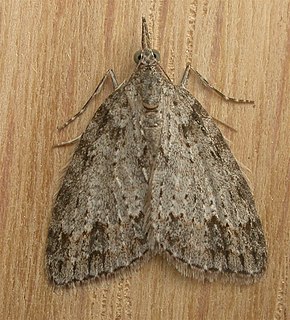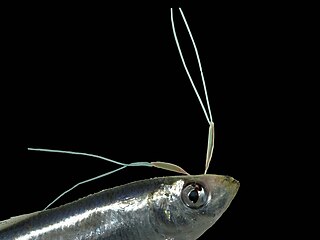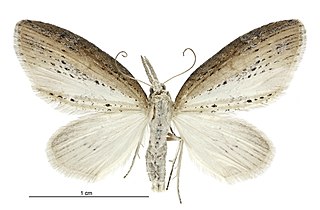
Larentiinae is a subfamily of moths containing roughly 5,800 species that occur mostly in the temperate regions of the world. They are generally considered a subfamily of the geometer moth family (Geometridae) and are divided into a few large or good-sized tribes, and numerous very small or even monotypic ones which might not always be valid. Well-known members are the "pug moths" of the Eupitheciini and the "carpets", mainly of the Cidariini and Xanthorhoini. The subfamily was described by Philogène Auguste Joseph Duponchel in 1845.

Microdes squamulata is a species of moth of the family Geometridae. It is found in Australia, including Tasmania.

Microdes villosata is a species of moth of the family Geometridae. It is found in Australia, including Tasmania.
Proteuxoa is a genus of moths of the family Noctuidae.
Microdes is a genus of moths in the family Geometridae.
Proteuxoa microdes is a moth of the family Noctuidae. It is found in New South Wales.

Pennellidae is a family of copepods, containing numerous genera, including:
Dikerogammarus is a genus of amphipod crustaceans, containing the following species:

Eupitheciini is a tribe of geometer moths under subfamily Larentiinae, often referred to as pugs. The tribe was described by Tutt in 1896.
Dikerogammarus haemobaphes is a species of freshwater gammarid crustacean. These gammarids are commonly known as demon shrimp, likely because they are an extremely successful invasive species. Native to the Ponto Caspian basin, Dikerogammarus haemobaphes expanded their range in 1955. This expansion began in Lake Balaton, Hungary and then spread into certain rivers and lakes in Austria, Belgium, Germany, Poland, Russia, Ukraine, and the United Kingdom. These crustaceans likely broadened their range due to the interconnection of waterways in Europe and the use of transportation vectors such as boats and ships.
Microdes arcuata is a moth in the family Geometridae. It is found in Australia.
Microdes asystata is a moth in the family Geometridae. It is found in Australia.
Microdes decora is a moth in the family Geometridae. It is found in Australia.

Microdes diplodonta is a moth in the family Geometridae. It is found in Australia.
Microdes leptobrya is a moth in the family Geometridae. It is found in Australia.
Microdes melanocausta is a moth in the family Geometridae. It is found in Australia.
Microdes oriochares is a moth in the family Geometridae. It is found in Australia.
Microdes typhopa is a moth in the family Geometridae. It is found in Australia.
Microdes quadristrigata is a moth in the family Geometridae. It is found in New Zealand.

Microdes epicryptis is a moth in the family Geometridae. It is found in New Zealand.






